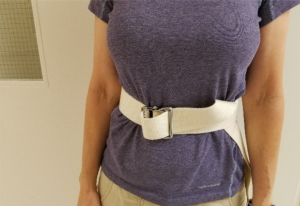4.2.4 Assistive Devices for Movement
Assistive devices are used to avoid injury to the client—and to you. Unfortunately, client care providers like Personal Support Workers can experience injuries at more than twice the rate of the general population (SE Research Centre, 2019). With this in mind, you should always opt to use an assistive device when one is available, even if it is less convenient.
Transfer/Gait belts
Transfer belts (or gait belts) are used to guide clients to a standing position with the benefit of being able to hold them securely, if needed, to steady them to stand. Transfer belts are not used to lift clients.
Below is a picture of one type of transfer belt. There are many available, including some with loops on the side.

Transfer belts come in many varieties, and you will need to review the manufacturer’s information for the correct way to apply and fasten the belt onto the client. After securing the belt around the waist of the client, make sure it is snug to the body but not tight. When you assist the client to walk, you will hold the back of the belt to assist, so it is necessary that you leave a comfortable space between the client and the belt to place your hand hold.
The following video shows how a transfer belt may be used to assist a client to stand.
Click here for a video transcript in .docx format: Video Transcript
Pivot Disc units
Pivot disc units are used for assisting a client to move from a sitting position to a standing position. They do not replace the ability to stand, but they are useful for clients that need minor assistance with movement, and can assist clients to move from a standing position to a sitting position.
Some pivot discs can be used for sitting or standing transfers; always follow directions of the manufacturer for use. The client must be able to weight bear in order to use these units. These units are used to pivot, not to transport clients.
Did You Know?
There are two types of pivot discs. Please click the links provided below to learn more:
What is the difference between these two style of units? Which unit would you choose if your client needs extra stability?
To use the pivot disc, complete the following steps in order:
- Make sure the disc is secure on the floor surface.
- Assist the client to stand per the directions above, placing their feet on the pivot disc instead of the floor.
- Assist the client to the standing position.
- Turn the pivot disc to position the client to the direction needed to walk or sit.
Always pivot the client to the strong side to allow the client to assist with the transfer.
This video shows the process of using the pivot transfer method.
Click here for a video transcript in .docx format: Video Transcript
Sit-to-Stand units
Sit-to-stand devices are used to transfer clients from one area or position to another (standing, turning, or sitting). Some are also used to move clients from one part of the room to another. All have a platform to place the feet on, knee braces, and bars to allow the client to grip to pull themselves up. Some models allow you to attach a belt to go around the client for increased safety during the stand, and have adjustable legs to go around chairs and wheelchairs. Some models are battery operated, and some are hydraulic.
This video shows the method of using a sit-to-stand machine.
Please note that there is no audio for this video, so no transcript is available.
Media Attributions
- gait belt © Michigan Medicine is licensed under a CC BY-NC-SA (Attribution NonCommercial ShareAlike) license

